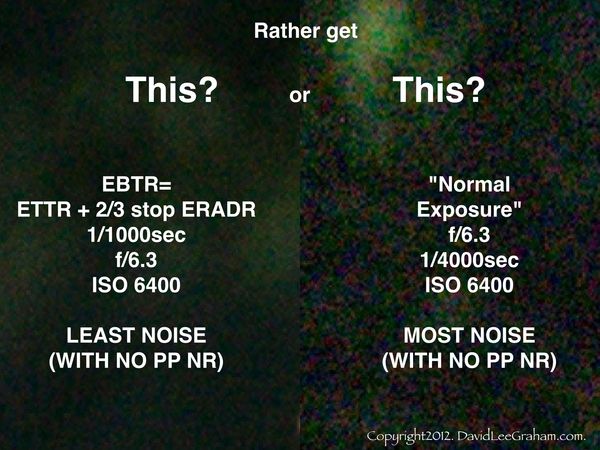Grain in my photos
Jul 8, 2014 08:56:56 #
I have taken some very satisfying shots with my 70D and various lenses but, I seem to always see more grain than I see in many other photos here (e.i. T150-600 on 6D vs 70D).
Here is an excerpt from page 2 of an article read this morning.
" The equivalent aperture not only tells you how much depth-of-field you get, on a different system, it also tells you how much total light you'll get. And, because the more light you capture, the less noisy your image, this is key to why large sensors generally give better image quality than small ones. This, as we said at the beginning of this article, was just as true when dealing with film formats: that's why people shot medium- and large-format film.
But surely F1.2=F1.2=F1.2?
Yes, it is. But F1.2 is not equivalent to F1.2 across different formats. "
This is page 2 of the article http://www.dpreview.com/articles/2666934640/what-is-equivalence-and-why-should-i-care/2" rel="nofollow" target="_blank"> http://www.dpreview.com/articles/2666934640/what-is-equivalence-and-why-should-i-care/2
I've now learned what "equivalent" means in tech camera world and how it applies to me. Fortunately for me, all but one of my lenses are for full frame. And, I think full frame is where I'm heading.
Any comments appreciated?
Thanks,
RegisG
Here is an excerpt from page 2 of an article read this morning.
" The equivalent aperture not only tells you how much depth-of-field you get, on a different system, it also tells you how much total light you'll get. And, because the more light you capture, the less noisy your image, this is key to why large sensors generally give better image quality than small ones. This, as we said at the beginning of this article, was just as true when dealing with film formats: that's why people shot medium- and large-format film.
But surely F1.2=F1.2=F1.2?
Yes, it is. But F1.2 is not equivalent to F1.2 across different formats. "
This is page 2 of the article http://www.dpreview.com/articles/2666934640/what-is-equivalence-and-why-should-i-care/2" rel="nofollow" target="_blank"> http://www.dpreview.com/articles/2666934640/what-is-equivalence-and-why-should-i-care/2
I've now learned what "equivalent" means in tech camera world and how it applies to me. Fortunately for me, all but one of my lenses are for full frame. And, I think full frame is where I'm heading.
Any comments appreciated?
Thanks,
RegisG
Jul 8, 2014 09:09:45 #
I have a 70D and the only time I see grain is when I am up at 6400-12800 ISO. I get excellent results with my FF 24-105mm 'L' from CANON and also my 70-300mm DG OS from SIGMA.
But then I may see grain when I blow the photo's up to 200%.
But then I may see grain when I blow the photo's up to 200%.
Jul 8, 2014 09:18:06 #
RegisG wrote:
I have taken some very satisfying shots with my 70... (show quote)
A full frame would let you shoot at a higher ISO - but crop sensors are improving all the time and are increasingly showing good performance at higher ISO than previous models.
Shoot within the ideal range of the camera and you shouldn't see appreciable 'grain' in your pictures - unless you are processing them and doing something to cause increased noise.
Jul 8, 2014 10:40:55 #
The following article may help you understand ISO and Image Noise. http://www.digital-slr-guide.com/iso-and-image-noise.html
Jul 8, 2014 10:55:44 #
amehta
Loc: Boston
RegisG wrote:
I have taken some very satisfying shots with my 70... (show quote)
The idea is that we can talk about actual focal length, aperture, and ISO, or we can talk about equivalent focal length, aperture, and ISO. The reason to mention the equivalent values is to have a common expectation across sensor sizes.
It does not matter if you have a full frame lens or an EF-S lens if you are using a 70D, the crop factor is the same and the equivalent calculations are the same.
"But surely F1.2=F1.2=F1.2?" No, because f-stop is a calculation. If you quote one of the numbers in your calculation differently, and say the lens is an 85mm lens instead of a 42mm lens, then the f-stop has to be stated differently also.
Jul 8, 2014 11:06:06 #
amehta wrote:
..."But surely F1.2=F1.2=F1.2?" No, because f-stop is a calculation. If you quote one of the numbers in your calculation differently, and say the lens is an 85mm lens instead of a 42mm lens, then the f-stop has to be stated differently also.
This may help with the last... http://www.uglyhedgehog.com/t-225613-1.html
Jul 8, 2014 11:14:29 #
amehta
Loc: Boston
St3v3M wrote:
This may help with the last... http://www.uglyhedgehog.com/t-225613-1.html
This links to the same article which RegisG referenced. :-)
Jul 8, 2014 11:16:24 #
amehta wrote:
This links to the same article which RegisG referenced. :-)
It has been one of those days. Thanks. S-
Jul 8, 2014 11:29:40 #
RegisG wrote:
I have taken some very satisfying shots with my 70... (show quote)
Get a noise reduction program. Some are even free. It will save you a lot of money.
Jul 8, 2014 11:36:11 #
Jul 8, 2014 20:43:15 #
RegisG wrote:
I have taken some very satisfying shots with my 70... (show quote)
xxxxxxxxxxxxxxxxxx
Here's a different take on noise:
The single most effective means of reducing noise is to reduce its capture!
How? Shoot RAW and utilize all possible DR existing to the right of the JPEG-adjusted histogram in your camera. This technique is termed Expose Beyond the Right (EBTR). How much DR is there? gotta experiment tomfind out...EACH CAMERA! I've tested more than one camera of a single model and found no two that shared the same amount of Extra RAW-Accesible Dynamic Range. One DSLR had 2/3 stop of ERADR; another had one and 2/3 stops, and a third had two and 1/3 stops! Gotta test every one.
To use that ERADR, set up ETTR exposure and add that camera's predetermined ERADR and make the exposure. With that exposure you may, for the first time, have actually use the appropriate exposure by which to capture the maximum of RAW image data quality...data with the highest Signal-to-Noise Ratio and thereby the lowest possible to practically no noise. How? By capturing all you image data as far away as possible from the mother lode of Noise way back there in the left half of the old JPEG-adjusted histogram.
But understand that that EBTR is not appropriate for all images. It is most conveniently employed for landscapes, portraits, and relatively stable subjects under unchanging illumination. Sports and active wildlife that move from sunlight to shade and back....not so good.
But when you do start using it you'll be absolutely amazed at the scant to almost imperceptible amount you'll capture.
Try it! You'll like it.
Note, I've tried twice to permit download, but have not succeeded.
Dave Graham
East River, SD.
Neither had PP Noise Reduction

Jul 8, 2014 23:59:10 #
Jul 9, 2014 06:27:32 #
Jul 9, 2014 07:26:09 #
Uuglypher wrote:
xxxxxxxxxxxxxxxxxx br Here's a different take on n... (show quote)
I'm trying to comprehend this but, sure like the result. You didn't say how to test a camera for ERADR. I like the idea of getting best shot possible in camera and relying less on pp.
Thanks,
RegisG
Jul 9, 2014 07:59:44 #
Post a sample. Click on "store original" and ask again. I want to see all the camera data, David
Any comments appreciated?
Thanks,
RegisG[/quote]
Any comments appreciated?
Thanks,
RegisG[/quote]
If you want to reply, then register here. Registration is free and your account is created instantly, so you can post right away.








